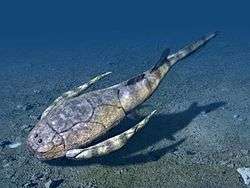Eonatator
| Eonatator Temporal range: Santonian–Campanian | |
|---|---|
 | |
| Scientific classification | |
| Kingdom: | Animalia |
| Phylum: | Chordata |
| Class: | Reptilia |
| Order: | Squamata |
| Family: | Mosasauridae |
| Subfamily: | Halisaurinae |
| Genus: | Eonatator Bardet et al., 2005 [1] |
| Type species | |
| Clidastes sternbergii Wiman 1920 | |
| Species | |
| |
Eonatator is a genus of halisaurine mosasaur from the Upper Cretaceous of North America, South America and Europe. Originally, this taxon was included within Halisaurus, but was placed in its own genus.[1] Eonatator is known from the Smoky Hill Chalk Member of the Niobrara Chalk Formation (Upper Coniacian - Lower Campanian) of Kansas, from the Eutaw Formation (Santonian) and Mooreville Chalk Formation (Selma Group; Santonian-Lower Campanian) of Alabama (United States), from the Kristianstad Basin of southern Sweden (late early Campanian), and the unit Nivel de Lutitas y Arenas (Campanian) in La Mesa, Colombia.[3] The name Eonatator means "dawn swimmer" (Greek eos = dawn + Latin natator = swimmer). Originally it contains only a single species, E. sternbergii. The species is named in honour of Charles H. Sternberg and his son, Levi, who discovered the type specimen in the Niobrara Chalk during the summer of 1918. A second species, E. coellensis, was named for the town of Coello in the Department of Tolima in Colombia, near of which it was discovered.[2]
Like many mosasaurs, this genus has a complicated taxonomic history. The type specimen (UPI R 163, Uppsala University Palaeontological Institute, Uppsala, Sweden), a nearly complete skeleton, was originally referred to the genus Clidastes by Wiman [4] and then to Halisaurus by Russell.[5] Hence, Clidastes sternbergii became Halisaurus sternbergii. However, by the late 1980s, some paleontologists began to suggest that H. sternbergii belonged in its own genus and that Halisaurus was polyphyletic.[6]
Bardet et al. (2005, p. 465 [1] ) diagnose Eonatator sternbergii as follows: "Ambiguous characters: premaxilla-maxilla lateral suture ending posterior to 9th maxillary teeth; tail about 40% of the head and trunk length (convergent in mosasaurines); caudal vertebra length greater than width; fewer than four pygal vertebrae; femur length about twice distal width (convergent in Clidastes). Autapomorphies: parietal with smooth triangular table extending very far posteriorly, bearing medium-sized circular foramen, located at distance twice its diameter from the frontal-parietal suture, and surrounded anteriorly and posteriorly by two parallel ridges; rounded quadrate with regularly convex tympanic ala (wing); vertebral formula: seven cervicals, 24 dorsals, four pygals, 28 median caudals and at least 41 terminal caudals; humerus length approximately 2.5x distal width." E. coellensis is diagnosed by more retracted nostrils, between the 7 and the 17 maxillary teeth, premaxilla and maxilla with a short rostrum anterior to the first teeth; presence of a septomaxilla, a large prefrontal that makes most of the margin of the outer nostril, a short and wide frontal, a parietal foramen located near of the fronto-parietal suture, a triangular surface of the parietal with two medial depressions and 22 caudal vertebrae.[2] A cladistic analysis of the Halisaurinae [1] has indicated that Eonatator is the sister group to the clade Halisaurus and that it represents one of the most basal of known mosasaurid taxa.
Eonatator was among the smaller mosasaurs. The length of the type skeleton, which represents an adult, is only 2.65 meters in length. Like many mosasaurs, it likely fed primarily on fish and smaller marine reptiles. The length of the type specimen of E. coellensis, IGM p 881237 (which lack a complete tail), is of 2.8 meters until the last preserved caudal vertebrae, with a skull of 41,5 centimeters. The specimen of this species is remarkable for having remains of soft tisue in the ear region, the neck, thoracic and the abdominal region. Under the pygal vertebrae and the seventeenth dorsal vertebra there is a series of 20 small vertebrae centra and a flated bone, that together measure 25 centimeters in length. It have features of the mosasauroids, with three vertebrae with haemal arches and procoelic centra, that suggest the possibility that these small bones belong to an embryo of this species, although the lack of diagnostic fossils like the skull or teeth prevents a complete identification. In any case, it will be consequent with the ovoviviparism previously reported in mosasauroids like Carsosaurus.[2]
References
- 1 2 3 4 Bardet N, Suberbiola XP, Iarochene M, Bouyahyaoui F, Bouya B, Amaghzaz M. 2005. A new species of Halisaurus from the Late Cretaceous phosphates of Morocco, and the phylogenetical relationships of the Halisaurinae (Squamata: Mosasauridae). Zoological Journal of the Linnean Society 143: 447-472.
- 1 2 3 4 Páramo-Fonseca, María E. (2013). "Eonatator coellensis nov. sp. (Squamata: Mosasauridae), nueva especie del Cretácico Superior de Colombia" [Eonatator coellensis nov. sp. (Squamata: Mosasauridae), a new species from the Upper Cretaceous of Colombia] (PDF). Revista de la Academia Colombiana de Ciencias (in Spanish). 37 (145): 499–518. ISSN 0370-3908.
- ↑ Eonatator coellensis in the Paleobiology database
- ↑ Wiman CJ. 1920. Some reptiles from the Niobrara group in Kansas. Bulletin of the Geological Institute of Uppsala 18: 9-18 (9 figs., pls. II-IV).
- ↑ Russell DA. 1970. The vertebrate fauna of the Selma Formation of Alabama. Part VII: The mosasaurs. Fieldiana, Geology Memoirs 3 (7): 369-380.
- ↑ Wright KR. 1988. A new specimen of Halisaurus platyspondylus (Squamata: Mosasauridae) from the Navesink Formation (Maastrichtian) of New Jersey. Journal of Vertebrate Paleontology 8 (Supplement 3): 29A-30A.
Further reading
- Lindgren J, Siverson M. 2005. Halisaurus sternbergii, a small mosasaur with an intercontinental distribution. Journal of Paleontology 79 (4): 763–773.
External links
| Wikispecies has information related to: Eonatator |


.jpg)
